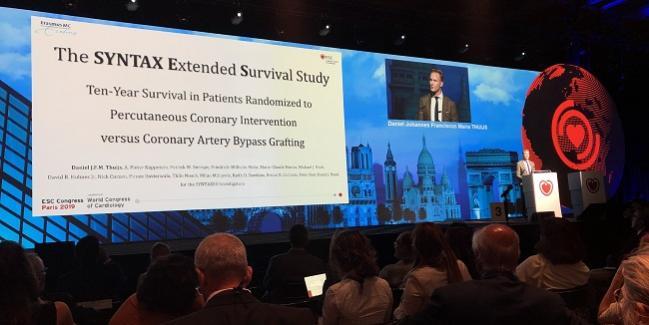Ten-Year SYNTAXES Results Fix Roles for CABG, PCI in Complex CAD
The results echo earlier 10-year findings released at TCT 2018: a CABG win in three-vessel disease, but not for the left main.

PARIS, France—The full and final 10-year results from the SYNTAX Extended Survival Trial (SYNTAXES) suggest that CABG confers a mortality advantage over PCI for patients with three-vessel disease, but also show that the two revascularization strategies are more or less equal for patients with left-main lesions.
In the overall cohort of nearly 1,800 patients in the SYNTAX trial, investigators found no survival differences between patients randomized to PCI versus those randomized to CABG.
The results, presented by Daniel Thuijs, MD (Erasmus University Medical Centre, Rotterdam, the Netherlands), at the European Society of Cardiology Congress 2019, echo the SYNTAXES presentation Thuijs gave nearly a year ago at TCT 2018, when just 71% of patients had surpassed the full 10-year follow-up. Speaking with TCTMD here following a press conference prior to his Hot Line presentation, Thuijs confirmed that the final data contain no new surprises beyond what he unveiled last year.
SYNTAXES was published simultaneously in the Lancet.
The original SYNTAX trial randomized 1,800 patients with de novo three-vessel or left main disease to CABG or to PCI with the first-generation Taxus stent (Boston Scientific). At 5 years, Thuijs said, results were “reassuring” in patients with left-main disease, with no differences in rates of all-cause mortality between the groups. For the three-vessel disease, however, survival curves had begun to diverge at 1 year and were clearly continuing to separate at the 5-year mark, prompting some to predict that the follow-up study might leave CABG the overall winner.
“I think many people—cardiologists and cardiac surgeons—would have expected the curves to [continue to] diverge,” Thuijs told TCTMD. “However, I think the basic Kaplan-Meier lines do not always tell the complete story, so when you do follow-up beyond 5 years, we can actually see what will happen.”
He reiterated this point in his concluding remarks during the Hot Line session, saying, “We would urge all contemporaneous trials to extend follow-up beyond 5 years.”
At 10 years, the patterns seen at 5 years and again for the incomplete follow-up last year continued to hold true for the trial cohort as a whole, as well as for the prespecified left-main and three-vessel disease subgroups.
All-Cause Mortality at 10 Years: SYNTAXES
|
|
PCI (n = 903) |
CABG (n = 897) |
HR (95% CI) |
|
All Patients |
244 |
211 |
1.17 (0.97-1.41) |
|
Left Main Disease |
93 |
98 |
0.90 (0.68-1.20) |
|
Three-Vessel Disease |
151 |
113 |
1.41 (1.10-1.80) |
A separate analysis, looking at outcomes according to SYNTAX score, showed that patients with the highest baseline scores (≥ 33) benefited more from CABG than from PCI, whereas patients with lower or intermediate scores fared similarly with either revascularization strategy.
The Gift of Long-term Data
In what Thuijs called a “slightly unexpected” finding, investigators saw no difference in survival between PCI and CABG among the patients with diabetes, a group singled out in clinical guidelines as being better served by CABG.
Gregg Stone, MD (Cardiovascular Research Foundation, New York, NY), the discussant for SYNTAXES, called SYNTAX “the gift that keeps on giving,” with new insights accumulating as the years have gone by. He, too, singled out the diabetes results as “intriguing” and confirming what was also seen in the EXCEL trial.
Speaking with TCTMD, Stone said it may be time to reevaluate whether diabetes should still be considered as such a powerful “differentiator” in the decision to choose CABG over PCI in diabetic patients.
For Stone, the different findings in the three-vessel disease and left-main patients also represent “a very important lesson,” he commented. “The overall primary endpoint was negative, so some people would say, well, there's no difference between PCI and CABG in these most complex patients with a first-generation DES, but I do think you need to look a little more granularly at the data and you do see a substantial interaction between triple-vessel and left main disease, which we have seen elsewhere, so this is not a stand-alone finding.”
Asked during the ESC session whether the results remained relevant, given the outdated DES technology that was studied, Stone countered that SYNTAX remains the largest comparison of PCI and CABG ever completed and has the longest follow-up, as well. Moreover, both stents surgical grafts will fail over time.
“I think these results should inform practice,” he said at the start of his talk, repeating the same point in response to the question. “I think these data are relevant: PCI has improved, but so has surgery.”
Shelley Wood is the Editor-in-Chief of TCTMD and the Editorial Director at CRF. She did her undergraduate degree at McGill…
Read Full BioSources
Thuijs DJFM, Kappetein AP, Serruys PW, et al. Percutaneous coronary intervention versus coronary artery bypass grafting in patients with three-vessel or left main coronary artery disease: 10-year follow-up of the multicentre randomised controlled SYNTAX trial. Lancet. 2019;Epub ahead of print.
Disclosures
- Thuijs and Stone report no relevant conflict of interests.


Comments